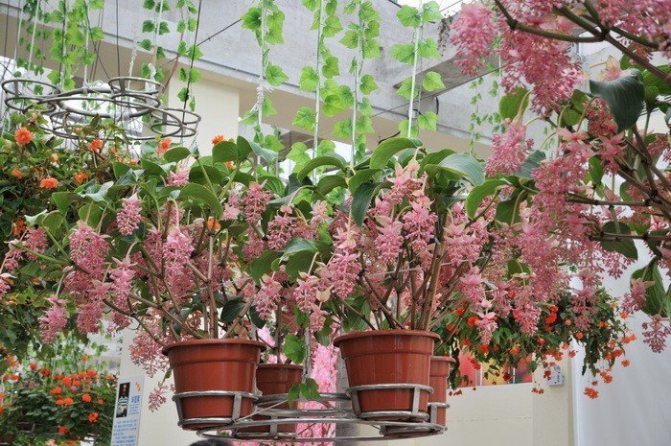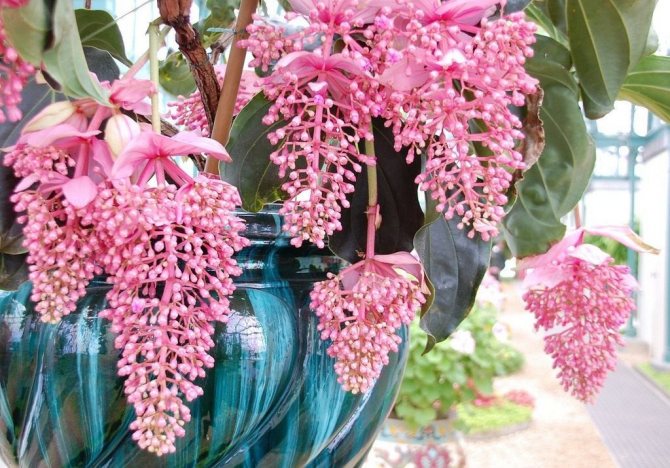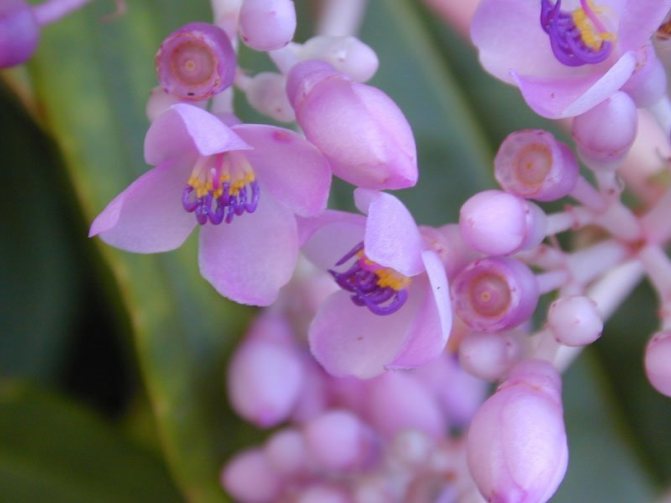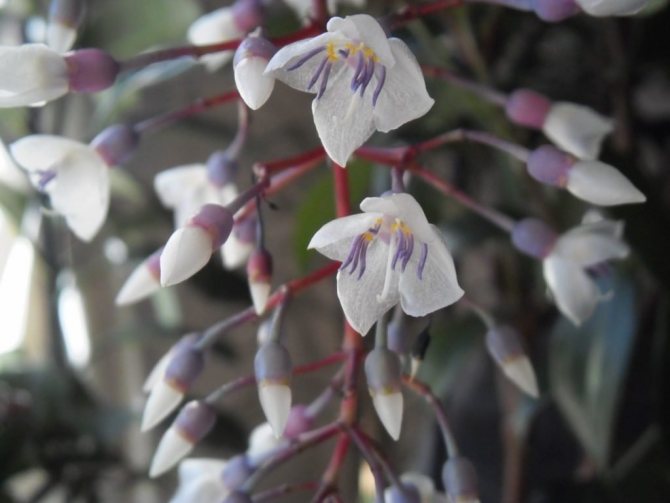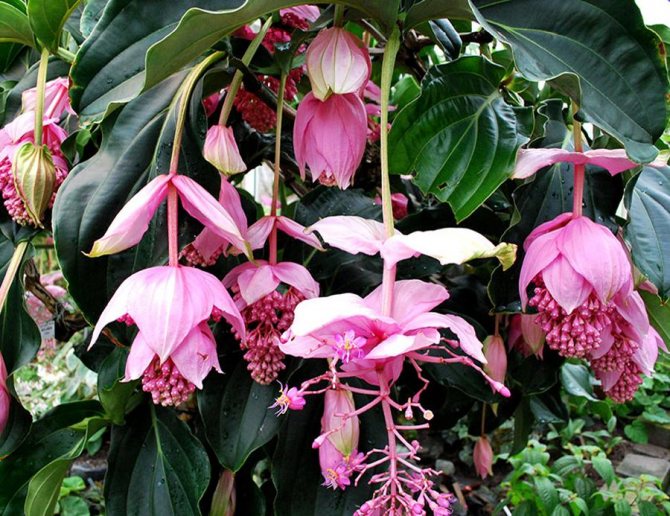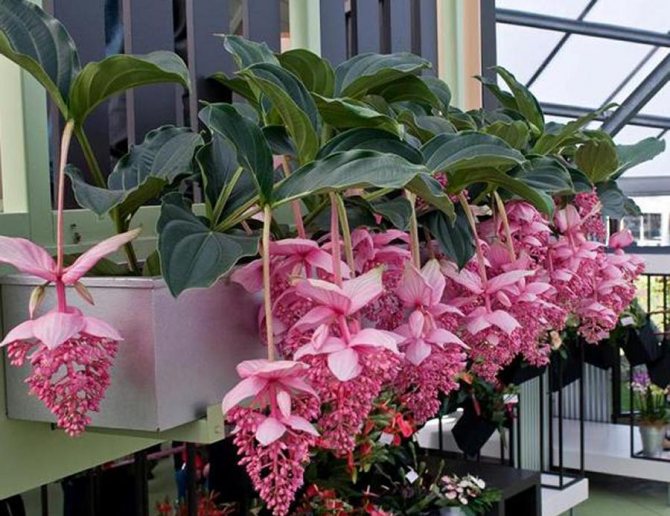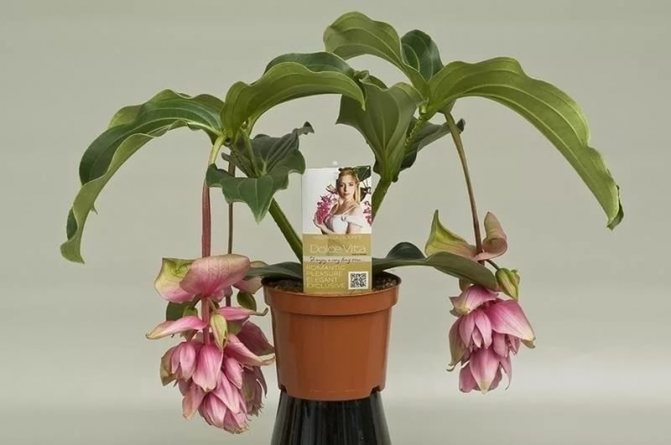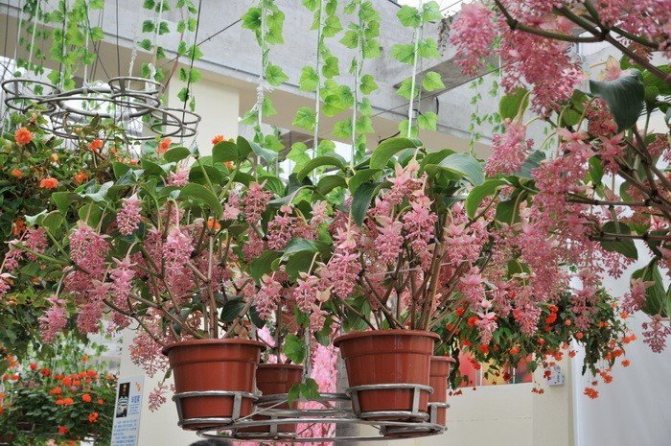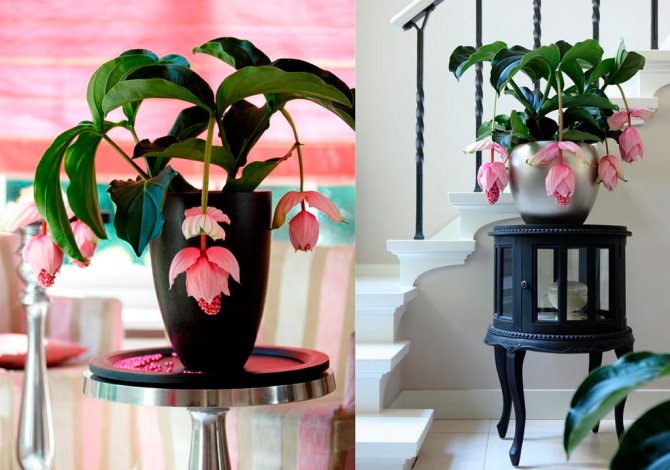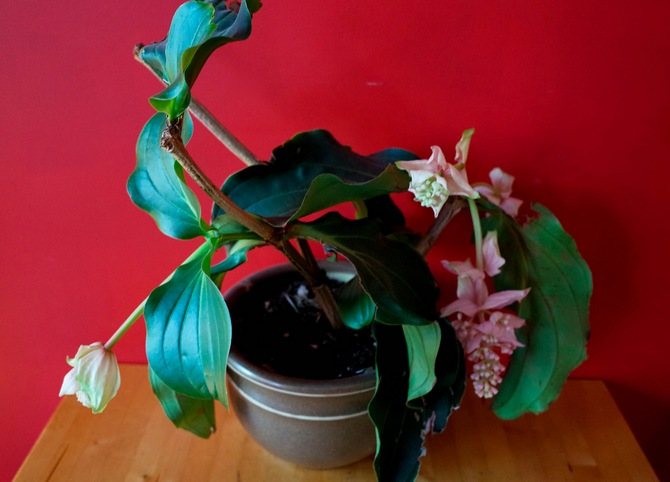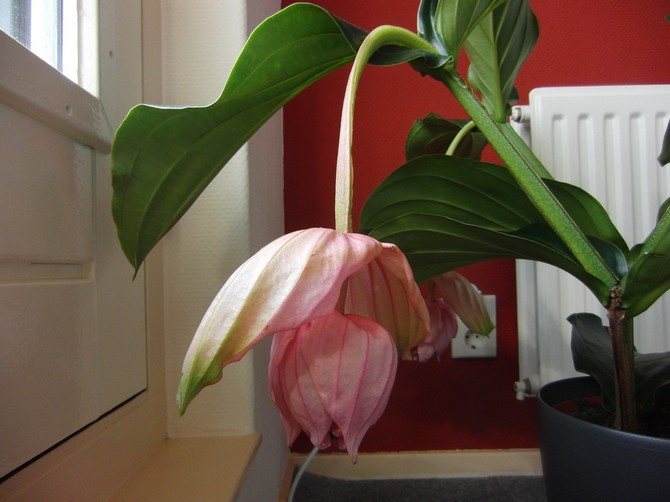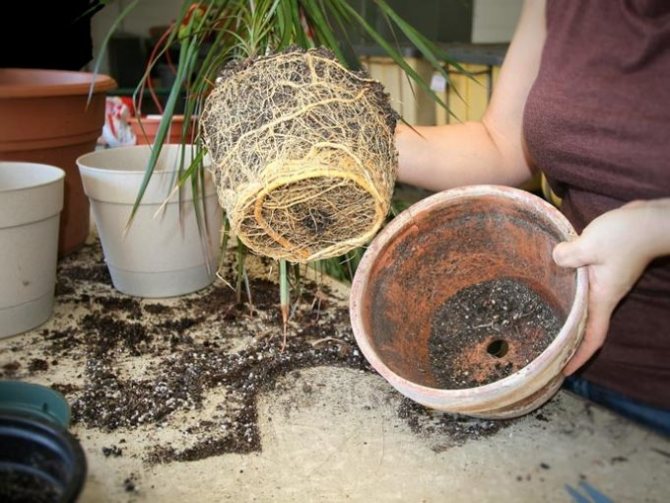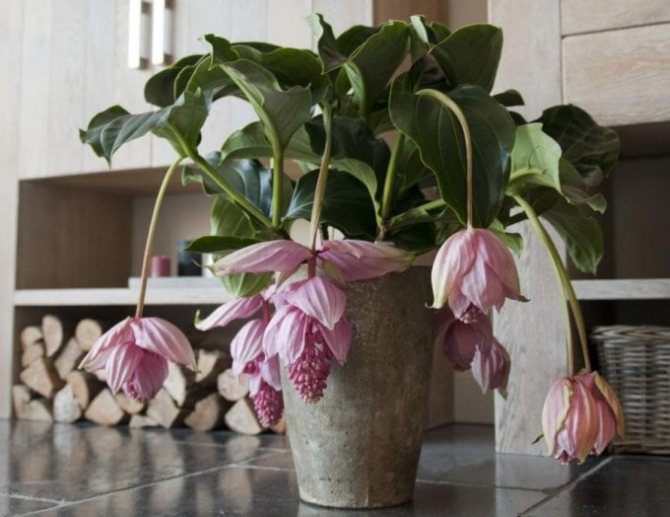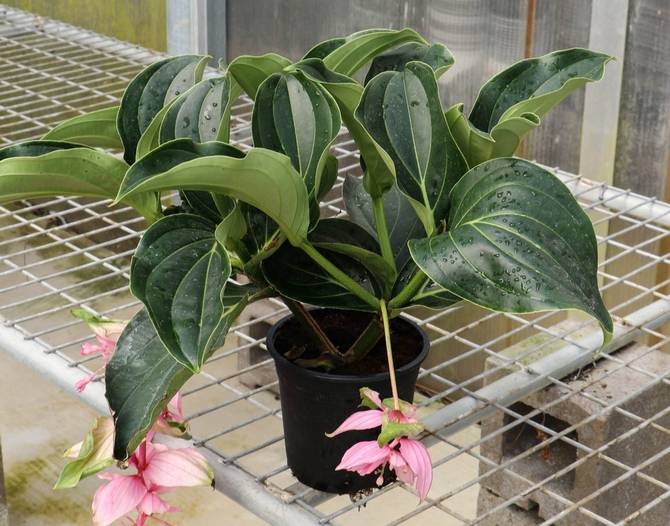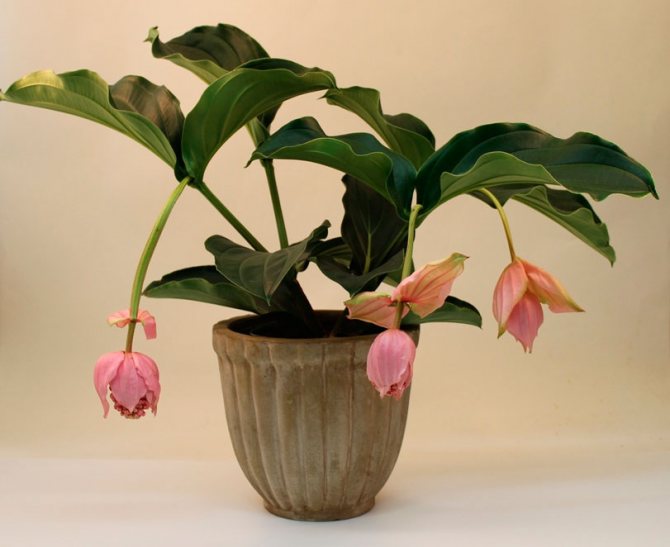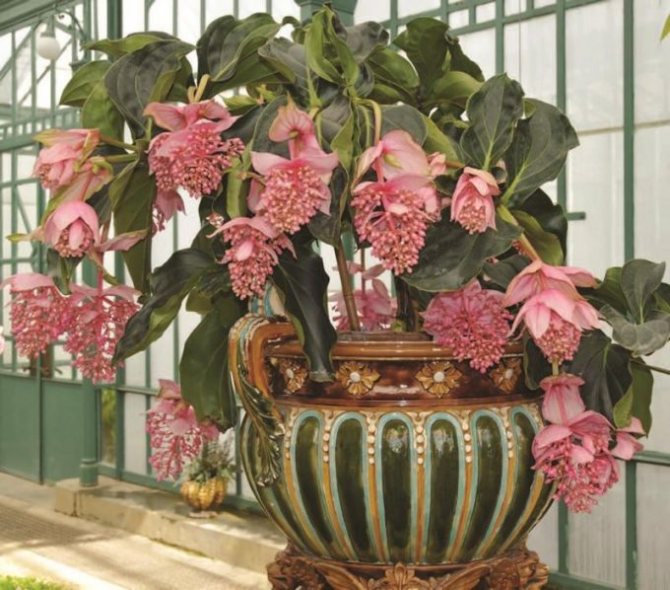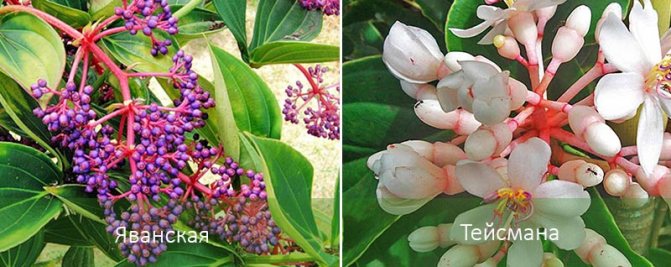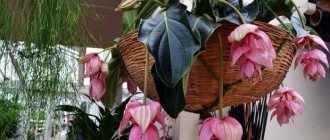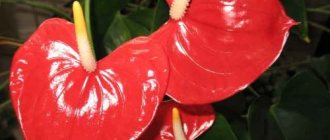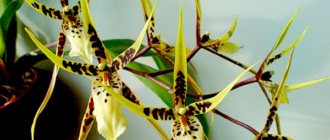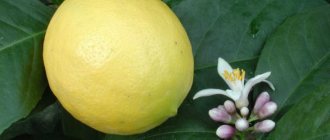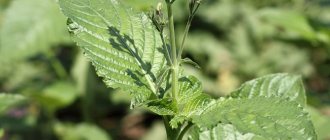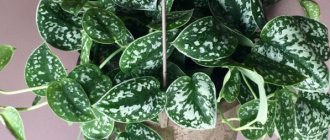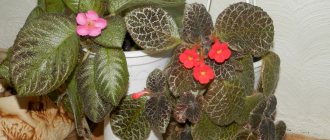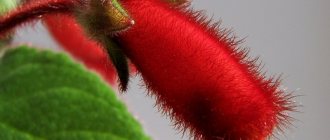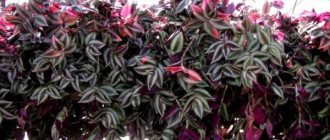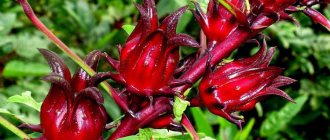Description of the flower and photo
The homeland of medinilla is the humid evergreen tropical forests of the Philippines, which with a bizarre variety of plant forms and a riot of colors resemble fabulous gardens.
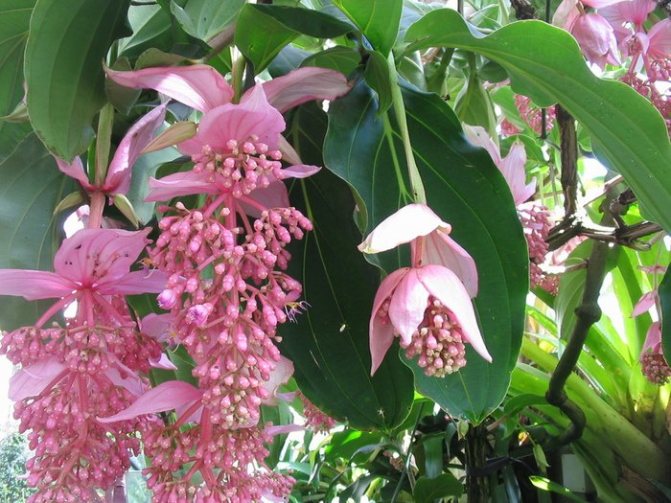
Homeland of medinilla - humid evergreen tropics
The genus includes more than 300 species of shrubs and lianas. Plants can grow up to 2 m in height. Their stems are covered with thickened leaves up to 30 cm in length, glossy, oval, grayish-green, with clearly visible light veins. But medinilla is still valued for its exotic flowering.
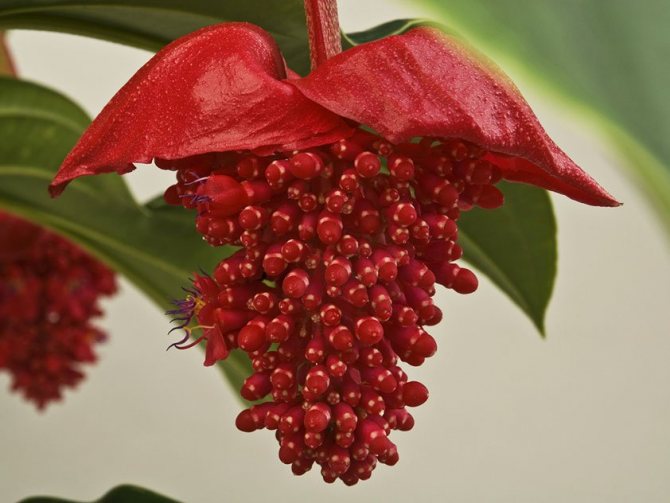

The plant is prized for its exotic flowering
She received the specific name "magnificent" due to the delicate bright pink drooping inflorescences in combination with large bracts.
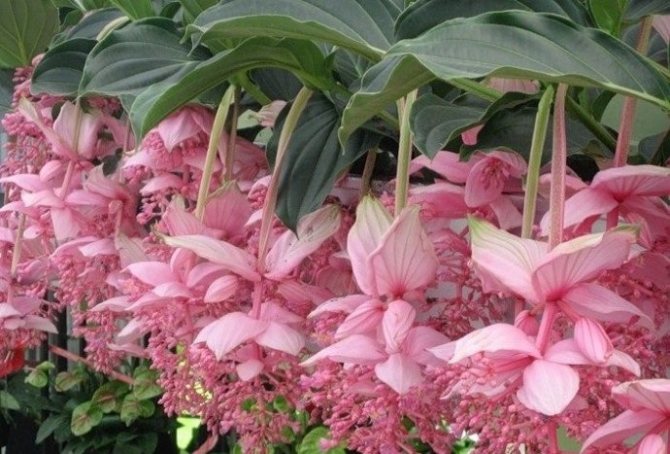

Medinilla gorgeous got its name from delicate bright pink inflorescences
This fragile beauty is not easy to grow at home. For her, not only the temperature regime and lighting are important, but also the location, compliance with all the rules of maintenance. However, knowing and taking into account all the subtleties of cultivation, you can achieve lush flowering.
Description of the medinilla magnifica flower
The main decoration of medinilla is hanging inflorescences. They come in various shades, but the most common are pale pink. Unusual flower leaves that look like artificial ones also attract the attention of flower growers.
Although Medinilla Magnifica is native to the rainforests of Africa and Madagascar, it owes its name to the governor of the Spanish colony.
The plant itself is very moody. Better not to move it from one place to another, because it will not want to bloom.
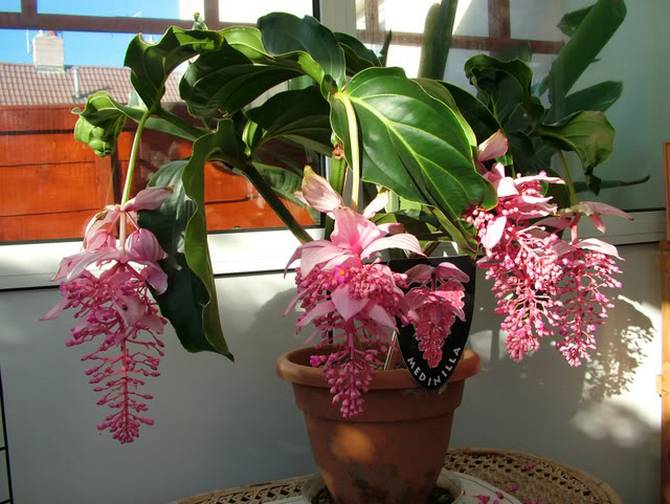

Medinilla flower at home in a pot
Views
As an indoor culture, only Medinilla is grown magnificent. Under natural conditions, the shrub grows up to 3 m in height, in an apartment - no more than 1 m. The leaves are leathery, oval, up to 30 cm long. On the upper side, they are dark green with venation, and a little lighter on the bottom. Flowering begins in April and ends in July. The flowers are pink, cupped, with 5 petals, collected in long cluster inflorescences (about 0.5 m).
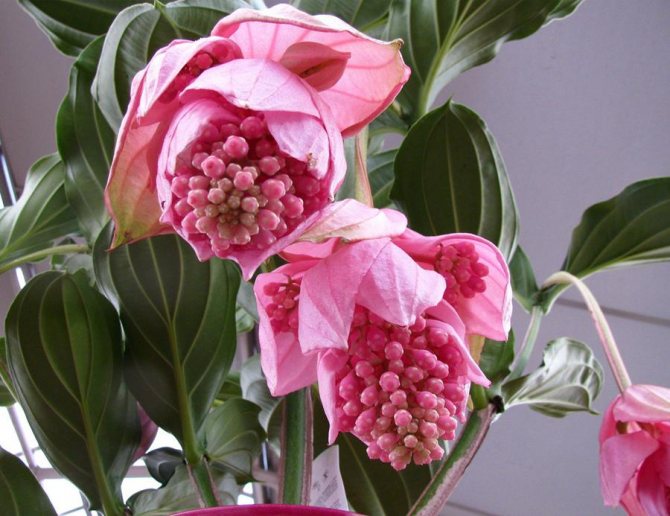

Medinilla is magnificent - a plant from the genus Medinilla of the Melastomaceae family
A characteristic feature of this species is large greenish-pink bracts. In the fall, blue-violet fruits ripen, similar to grape bunches.
In addition to gorgeous medinilla, growers also grow its hybrids.
- Zhadore Dolce Vita is a plant with deep pink flowers. Numerous narrow bracts are evenly distributed along the flower race.
- Medinilla venous is a shrub with thin shoots. Decorative dark green oval leaves with a pointed edge, 9–20 cm long. Leaf blade with embossed venation. Under the foliage are inflorescences with white tubular flowers.
- Medinilla sedum-leaved is a dwarf species with creeping shoots no more than 15 cm long. Leaves are dark green, leathery, with a faintly visible central vein. A rounded leaf blade with a diameter of slightly more than 0.5 cm. The flowers are bright pink, with white long filaments, bloom along the entire length of the shoot. Their diameter reaches 1.5 cm.
- Medinilla Javaniks are less capricious in nature. Short bushes with dark green ovoid leaves grow well in rooms with normal humidity.The drooping racemes are bright purple; bracts are absent.
- Medinilla Cuminga is a low, spreading shrub with shiny oval leaves up to 30 cm long. The surface of the sheet is slightly concave. Pink flowers are collected in racemose inflorescences.
Varieties in the photo
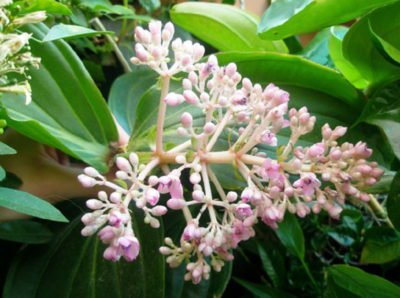

Medinilla javanica is famous for its less capricious character Medinilla sedum-leaved - a dwarf species with shoots no more than 15 cm
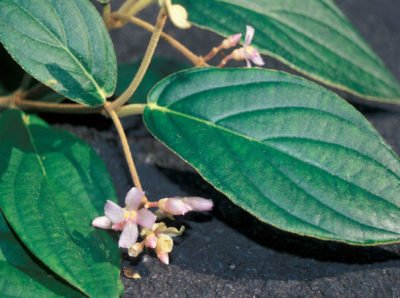

Medinilla veiny has beautiful dark green oval leaves
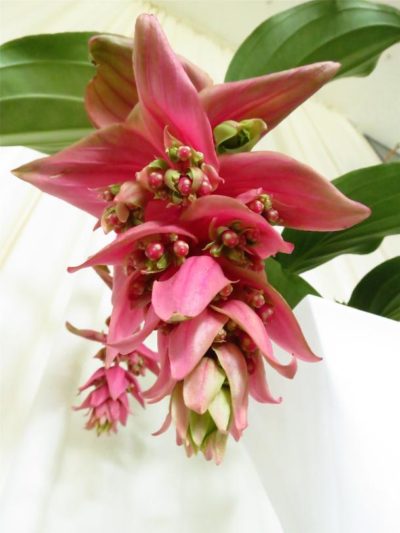

The flowers of medinilla Zhadore Dolce Vita are distinguished by a more intense pink color.
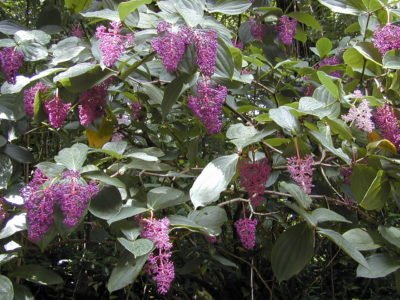

Medinilla Cuminga is a low, spreading shrub
Features of medinilla
Outwardly, medinilla looks like a small shrub, its height usually does not exceed two meters. The branches of the plant are erect, ribbed and bare, but sometimes they can be covered with small bristles. They are flexible at first, but harden with age. The leaves are rich green, smooth, large, with a glossy surface and pronounced veins (from 3 to 9 veins). There can be three types: opposite, sessile and short-petiolate. Their shape is elliptical or broad-lanceolate.
Medinilla flowers blooming in spring are very beautiful, for which they are appreciated by flower growers. They are collected in inflorescences hanging down in the form of heavy bunches. The flowers themselves are small, cupped, tubular or bell-shaped, have 4-5 petals. Their color is pink, white, pink-red. In some plant species, they are surrounded by large bracts that fall off at the beginning of the flowering period.
The fruits of the plant are fleshy, pear-shaped or oblong. Inside the pulp are smooth brown seeds. The root system is fibrous, highly branched.
Conditions of detention
For room medinilla, it is necessary to create conditions close to the natural habitat.
Comfortable growing conditions - table
| Lighting | Medinilla prefers to grow in a bright place, but not in bright open sun. Even light partial shade can adversely affect flowering. Reacts well to additional artificial lighting, especially in winter. The distance from the lamps to the plant should be at least 60 cm, so the leaves will not be burned. The best place is a window of the east or west direction; on the south side it is necessary to protect from sunlight. |
| Temperature regime | The optimum air temperature during development is + 20 ° С. During the dormant period, the room should not be lower than + 16 ° C - the cold is destructive for the flower. The fragile beauty should be protected from drafts. |
| Humidity | The plant feels good in a humid microclimate - the air humidity is more than 70%. Dry air can lead to yellowing of the leaves and even the death of the flower. Therefore, it is necessary to often spray medinilla, you can put a pot with it on a pallet with damp decorative stones. During the heating season, the flower should not be kept near the radiator. |
| Watering | In spring and summer, regular watering is needed once a week. However, it is impossible to overmoisten the soil - this can cause rotting of the roots. In winter they water less often. |
| Fertilizer | In spring and summer, every 2 weeks they are fed with mineral fertilizers. In winter, feeding is not carried out. |
| Transfer | Young plants are transplanted annually, adults - once every 3 years. |
| Pruning | After flowering, the medinilla is cut off and some of the overgrown shoots are removed. |
| Reproduction | Propagated by seeds, cuttings. |
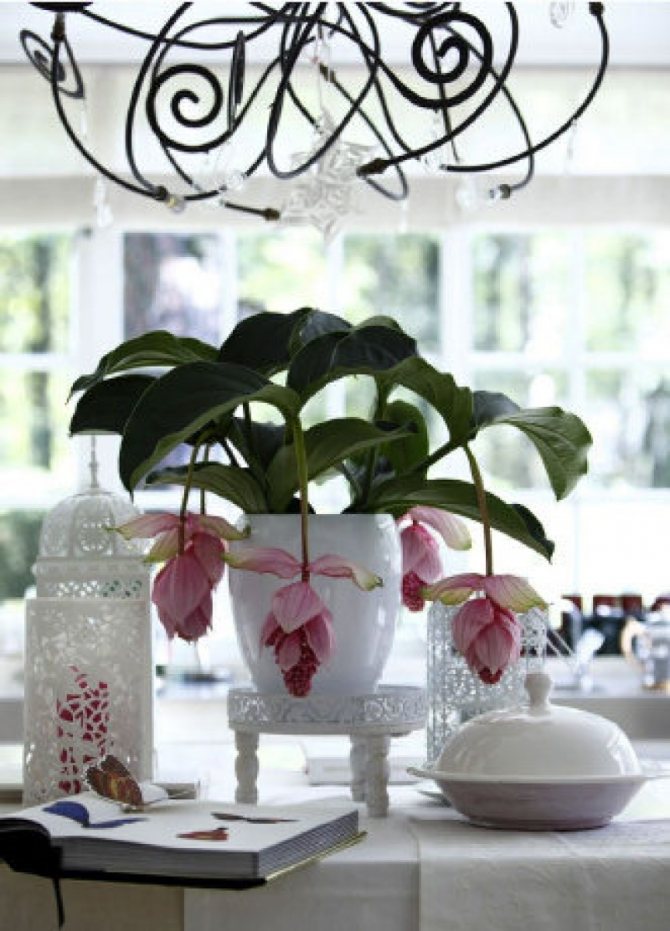

For room medinilla, it is necessary to create comfortable conditions
The plant feels comfortable in a greenhouse and an open-type florarium. Especially dwarf species - medinilla sedumous with creeping shoots and bright pink flowers grows well in the terrarium, where a comfortable and mild microclimate with high humidity is created.
On a note.A florarium is a composition of fresh flowers grown in a glass terrarium - a jar, a glass, an aquarium. The “garden in a bottle”, made up of plants and decorative elements (driftwood, pebbles), will decorate any interior.
Medinilla needs space, she does not like close proximity with other flowers.
Temperature regime for growing medinilla
Since the plant is native to the tropics, it needs constant warmth, high humidity in the air, sufficient lighting, protection from direct sunlight.
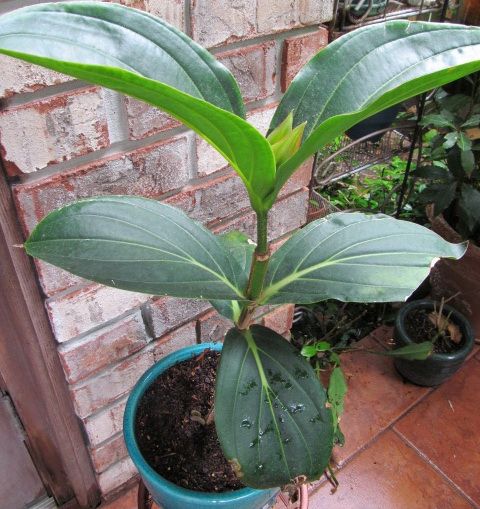

To create proper growth for the plant and enjoy its bloom twice a year, it is sufficient to maintain a room temperature of twenty-three degrees Celsius on average. The winter season for the plant is combined with a dormant period. At this moment, the temperature is allowed to be reduced to fifteen degrees. In this state, medinilla forms its flower buds.
Home care - watering rules
This point is important, since the cultivation of medinilla provides for the constant maintenance of the moisture content of the soil composition. It is not recommended to bring the soil to a dry state, since the plant is quite capable of dropping buds and even inflorescences. In the summer, watering should be moderate, carried out with clean water, the temperature of which corresponds to room temperature. In the winter season, moisture is added in moderate doses. For medinilla, the air must have a high percentage of humidity. For this reason, the plant should be sprayed several times a day.
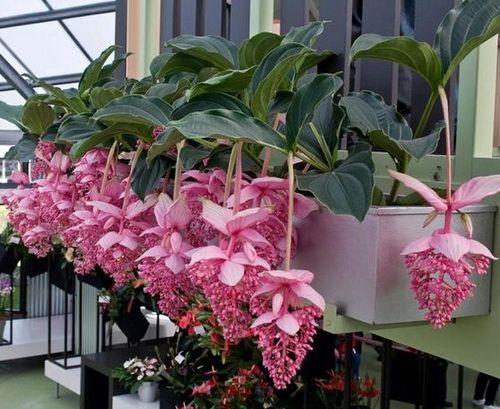

Soil composition for plant and fertilizer
A large amount of soil is not required for the plant for normal development to take place, a small pot is enough. But there is one condition - the availability of high-quality drainage is mandatory. In the first years of growth, the plant must be transplanted.
In the process of growth, the flower loves liquid feed formulations containing mineral components. This measure helps to create a good appearance and form a huge number of peduncles. In the summer, it is recommended to carry out several fertilizing with organic compounds on the foliage of the plant.
Several recommendations for growing medinilla, reproduction
Negative factors that impair the growth and proper development of medinilla include a lack of lighting, a low percentage of humidity in the room, poorly organized watering, low temperature limits, water that is unrefined or containing chlorine or lime, and plant movement on the eve of the flowering period. All these negative manifestations can cause the plant to shed foliage and flower buds.
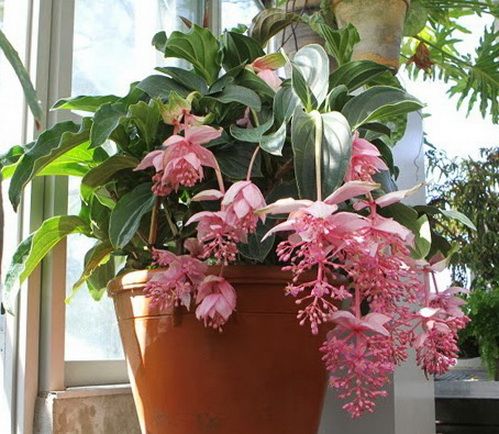

At the end of flowering, medinilla, if it has grown strongly, is recommended to be cut. In this case, the resulting cuttings may well try to root. In this case, an increased temperature is required, from twenty-five to thirty degrees Celsius and high air humidity.
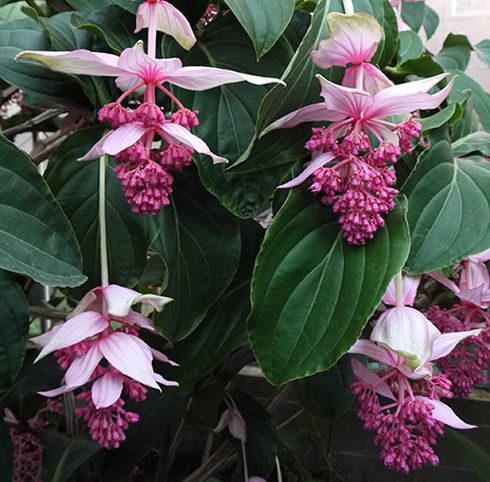

Medinilla is mainly propagated by seed. With proper care, you will have the opportunity to enjoy the beautiful view of this flowering plant every year. The spectacular appearance of the plant fully compensates for the whims of the plant, manifested by changes in temperature and humidity.
Planting and transplanting a houseplant
Medinilla develops well and blooms in a slightly acidic substrate. The soil should be light, breathable and nutritious, consisting of peat, humus and sand. They also use ready-made soil mixtures for rhododendrons, azaleas.
Since the flowers of the tropical beauty gracefully droop, high pots are selected for her. To avoid stagnation of water, expanded clay, crushed polystyrene with a layer of 3 cm, is placed on the bottom of the container.


Only tall pots are suitable for a tropical beauty
Young plants are reloaded annually, adults - once every 2-3 years. They are transplanted after flowering and pruning are completed, taking care not to damage the rhizome.The transplant is carried out only when there is a need for it. Medinilla has a very sensitive root system, which should not be disturbed once again. You can simply replace the topsoil (5–7 cm) regularly with fresh soil without changing the pot.
When buying in a store, pay attention to the stem - it should be green and without spots, the foliage should not show signs of yellowing. A healthy plant must be transplanted into a new soil, giving it several hours to adapt to new conditions. The leaves are pre-washed with warm water, rinsing off the preparations with which the plants are treated before sale. The earthen lump should dry thoroughly.
When transplanting, pay attention to the root system
- The pot is selected 5 cm larger than the previous one.
- Drainage is laid at the bottom with a layer of 3 cm. Expanded clay, gravel, pieces of bark can be used as drainage material.
- Carefully remove the delicate plant from the container.
- Examine the roots - they should be light, without damage.
- The top layer of soil is removed from the coma.
- Placed in a pot and cover with new substrate.
- Water and spray.
If there are a lot of flowers, they put props so that the shoots do not break off, and powerful stems are carefully tied to them. Medinilla can be grown in ampelous form in hanging baskets, vessels on pedestals, stands and picturesque stools.
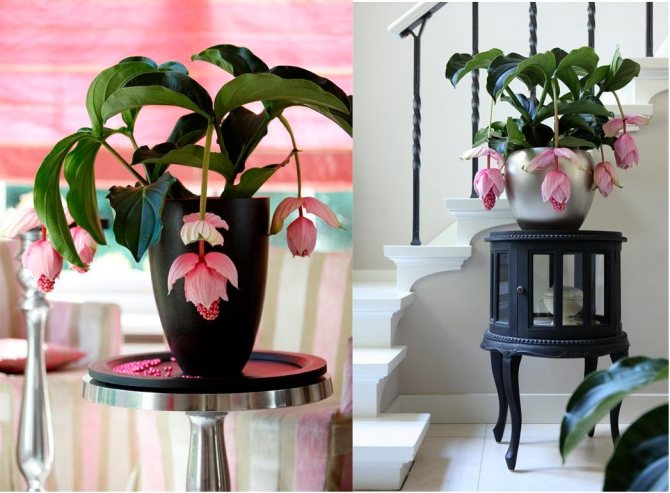

Medinilla can be grown as an ampel in pots on pedestals
Home care
The flower is rather capricious, demanding on the conditions of detention, does not tolerate being rearranged from place to place, even turning the pot.
Watering
Medinilla needs to create a comfortable, humid environment. Therefore, you should spray the plant more often, wipe the leaves with a damp cloth. At the same time, make sure that no water gets on the substrate or buds.
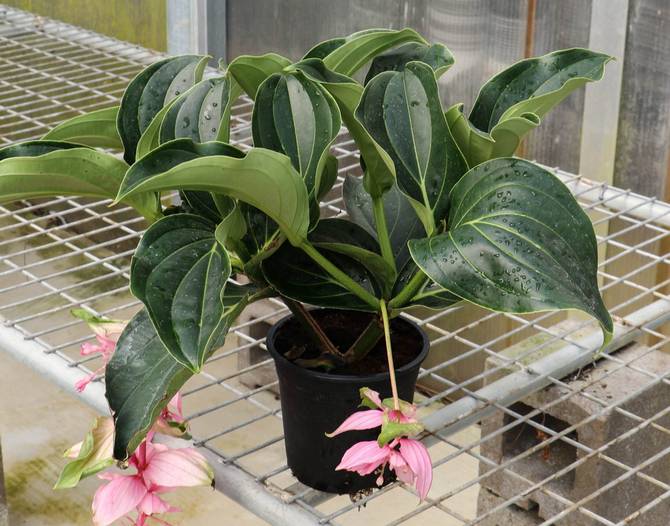

Medinill should be sprayed with water more often, have a shower
In the spring and summer, watered once a week. During the dormant period, watering is reduced, allowing the soil to dry out to a depth of 3 cm. This mode of light moistening is observed until the buds appear. Then the volume and frequency of watering are sharply increased, but without leading to waterlogging. A significant saturation of the substrate with moisture and a simultaneous increase in the temperature regime will give the plant an impetus to more lush flowering.
Medinilla is watered only with soft water. The presence of a large amount of salt in the water can lead to diseases.
Recent Entries
6 rare tomato varieties of 2020 that will bring you a decent harvest 5 cucumber hybrids that I will plant this year without hesitation 8 budget tips for summer cottages that will save money and time
Top dressing
Fertilizers are very important for the plant - they ensure its growth and abundant flowering, as well as resistance to diseases. From March to August, they are regularly fed every 2 weeks with liquid fertilizer for rhododendrons or flowering plants. No feeding is carried out from August to February.
For top dressing, complex fertilizers for indoor flowers are used.
To maintain immunity, it is useful to carry out a cycle of spraying the bush with Epin's solution.
Possible problems and ways to solve them
- The plant does not bloom, or there are very few flowers on it. There may be several reasons: incorrect temperature conditions, insufficient illumination, low air humidity. If these shortcomings are corrected, medinilla will begin to bloom;
- The flower began to shed buds and leaves. Most often this happens if you often rearrange it from place to place. The plant needs a stable and constant light source. The reason may also be too low humidity levels;
- The leaves become small and begin to curl. Again, you need to provide the plant with normal air humidity;
- Dark brown spots appeared on the shoots. This is a clear sign that the plant is affected by a fungus and may die from this.It is urgent to remove the affected shoots, and then treat the flower with fungicides. Fungal diseases often develop due to excess moisture in low light. You need to constantly monitor the ratio of humidity and light;
- Medinilla is sold in the store. It is not recommended to buy discounted flowers, since, most likely, they are affected by some kind of disease, and it will not be possible to reanimate them.
Now read:
- Exquisite junkus (sitnik) spiral in the interior
- Choosing cucumbers for open ground according to your preferences
- Varieties, planting and care of perennial rudbeckia
- Decoration and spicy pepper dish on the windowsill
About
Agronomist of the state agricultural enterprise "Garovskoye", Khabarovsk district, Khabarovsk region.
Bloom
At the end of winter, the plant wakes up - new leaves grow, and in April, flower stalks. The period of emergence of buds and disclosure of flowers is long, about one and a half months. The flowering itself lasts the same time. The flowers have no smell.


Medinilla Cuming has flowers collected in racemose inflorescences
The peduncle's arrow with withered flowers should be cut off - this stimulates the appearance of new inflorescences. After flowering, the stems on which there were flowers are shortened by half.
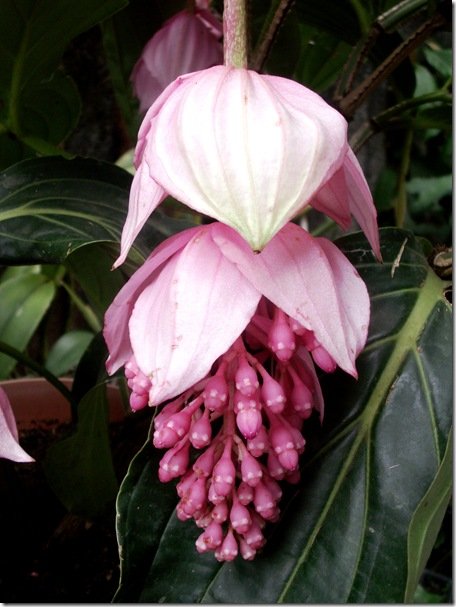

The flowers of medinilla gorgeous hang beautifully on long peduncles from the green mass of the bush
If medinilla does not bloom, it means that in winter it was looked after incorrectly.
Dormant period
There is a dormant period from November to February. At this time, flower buds are laid. Therefore, the conditions of winter keeping are so important. The plant is transferred to a cooler place (+ 15–17 ° C) with bright lighting, watering is reduced, but the soil is not oversubscribed. If medinilla does not receive enough light in the winter months, then it may not bloom in the future. Therefore, in a dark place, it is necessary to additionally use lighting devices, for example, fluorescent lamps.
Plant formation
Form medinilla after flowering: remove all peduncles, cut off the crown, giving the bushes a neat look.
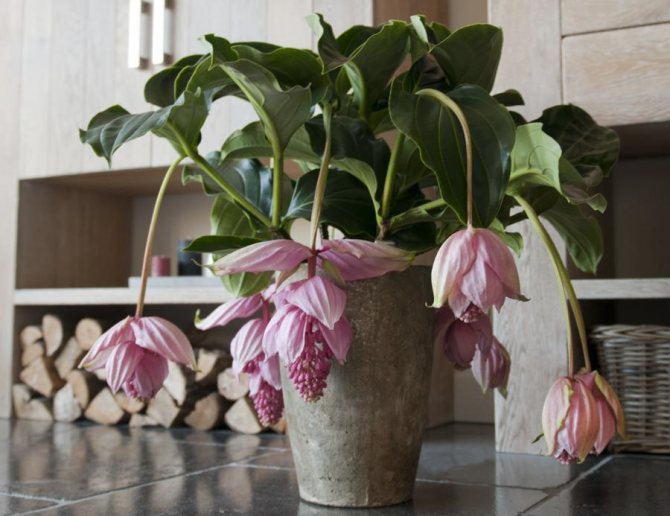

Formative pruning is carried out after flowering.
Watering
This moisture-loving plant should be regularly watered with soft, settled water at room temperature. Even a slight drying of the soil will lead to drying out of the tips of the leaves and shedding of flowers. During the formation of buds, the soil must be constantly moist. But do not allow swamps, excess water from the pot should flow freely into the pan, from where it should be removed in a timely manner. During flowering, the intensity of watering is slightly reduced, and during dormancy it is completely reduced to a minimum and watered only after the soil in the pot dries out by half. The rule applies here - the lower the temperature, the less watering.
This might be interesting: Lantana - home care
What happens when a flower is improperly looked after
Even the smallest changes in the environment or care are immediately reflected in the condition and appearance of the tropical capriciousness.
A less capricious plant is the peacock flower or episode. You can find out about the conditions of its cultivation from the material:
Care errors and what to do to eliminate them - table
| Errors | How to fix the situation |
| The plant does not bloom, new leaves are small. | The microclimate is too dry. Increase the humidity of the air, spray the bush as often as possible. |
| Falling buds and flowers. | The reasons are short daylight hours, drafts, movement of the flower. Use additional lighting, protect from drafts, do not move the pot. |
| Light spots on the leaves. | Occur as a result of excessive lighting. It is necessary to shade the bush from the bright sun. |
| In winter, foliage dries. | The reasons are a very cool room, waterlogging. Increase the temperature in the house, let the soil dry out. |
| Leaves dry up in summer. | The apartment is hot and dry. Maintain the air temperature no more than +25, spray the leaves. |
| Blackening of the stem and leaves. | The plant suffers from excess moisture, cold. Establish proper watering, moisten the soil only after the top layer of the earth has dried. Maintain optimal temperature values depending on the season. |
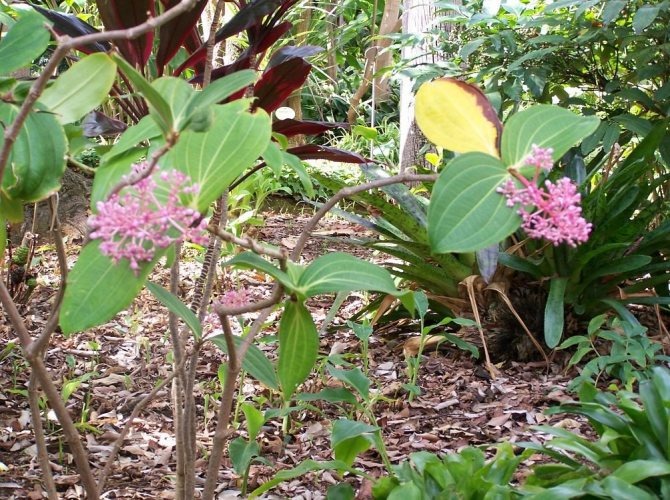

Bright rays of the sun cause leaf burn
Diseases and pests
Medinilla is distinguished by strong immunity, but if the substrate is excessively moistened, it can suffer from rot, and during drought it can be affected by worms. The flower can become infected from other indoor plants or react painfully to irrigation or lighting irregularities.
| Diseases / pests | Symptoms | Prophylaxis | Control measures |
| Gray rot, or botrytis | Dark spots appear on stems and leaves. | Avoid excessive soil moisture, strengthen plant immunity, fertilize in time. |
|
| Schervets | White lumps appear on the surface of the leaves. Sucking insects retard plant growth, cause yellowing and drying of leaves. | Maintain high air humidity - it inhibits the development of parasite colonies. |
|
| Spider mite | Yellowish dots form on leathery leaves. The plant dries up. | The pest loves the heat - in order to prevent it, it is necessary to irrigate the leaves with warm water. |
|
| Shield | It sucks the sap from the plant, depletes it and leads to yellowing. | Inspect plants periodically for parasites. |
|
| Aphid | Eating on sap leads to leaf lethargy and drying of the shoots. | Regularly inspect the flower garden for the presence of parasitic insects. Monitor the temperature regime, ventilate the room. |
|
Examples of pests in the photo
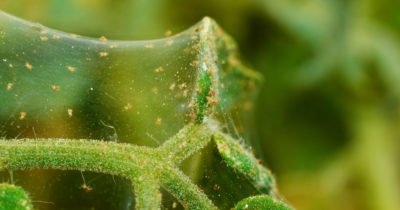

Spider mites love dry air and heat
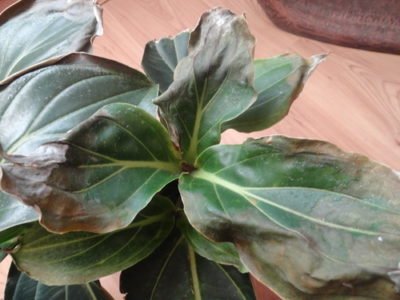

Botrytis-infected plants develop spots on the leaves
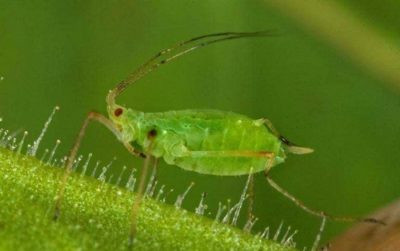

Feeding on the sap of plants, destroys them
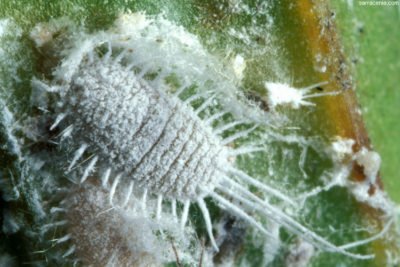

The worm causes yellowing and drying of the leaves
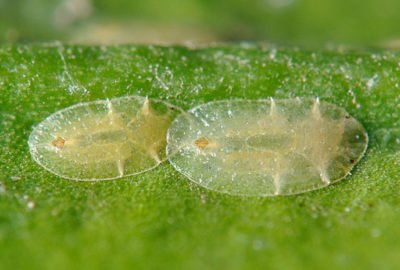

The scale depletes the plant, leading to yellowing
If there is not enough light, then the plant may not start the flowering period or throw off existing flowers. Therefore, during the absence of the sun, special lighting devices should be used, for example, fluorescent lamps.
Humidity
The plant will feel comfortable only in a room with high ambient humidity, i.e. at 70-80% throughout the year. To achieve this, spray the leaves daily with water at room temperature. During flowering, try not to hit the buds and opened medinilla flowers with a stream. Place a wide container of water near the pot to evaporate it. If you have a household humidifier, turn it on if you suspect that the humidity level drops below 70%. This is especially true for the winter period, when heating devices work in the house, which significantly reduce the level of humidity in the premises.
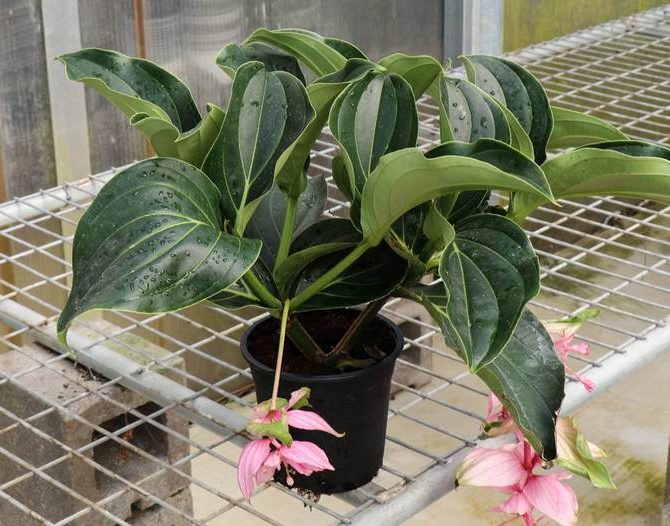

From dry air, the foliage of the plant becomes smaller, medinilla loses its attractiveness and resistance to diseases and pests. Therefore, as soon as the flower begins to lose its decorative effect, urgently increase the humidity of the air, at least near the pot. Cover hot batteries with damp towels. Place the pot in a tray with wet expanded clay.Just make sure that the roots of the flower do not touch the water.
When creating high humidity in a warm room, there is a high probability of fungal diseases. To prevent them, regularly ventilate the room, while not forgetting that the flower should not fall under a stream of cold air.
The plant loves a warm shower for the stems and leaves, but it is important to avoid getting moisture on the flowers. The soil in the pot should also be covered with plastic to prevent it from being washed out of the pot.
Cleanliness is the key to health
We draw your attention to the fact that the purity of the surface of its leaves is important for the health of medinilla. If the leaves are covered with a thick layer of dust, the flower can get sick. After all, a layer of dust closes the pores on the leaves, complicates air exchange with the environment. In addition, the dust layer impairs the process of photosynthesis, and if it is not removed, medinilla will begin to suffer from nutritional deficiencies. Moreover, dust can cover harmful substances and be a refuge for harmful insects.
Therefore, it is necessary to regularly (once a week) wipe the leaves with a damp soft cloth or sponge. To make it easier, first spray the flower with warm water. Carry out this event in the morning, so that by the evening the plant will dry out.
Sometimes, for greater beauty, the leaves are given a gloss with the help of folk remedies. For polishing, use beer, milk or a weak solution of vinegar. But this gloss can only be applied to mature plants. Young bushes should not be touched.
Reproduction
Propagated medinilla seeds and cuttings.
Cuttings are carried out in the spring.
- Cut the cuttings 8 cm long.
- The cutting edge is treated with Kornevin and rooted in moistened sand. Cover with foil or a transparent glass to create a humid microclimate. In the greenhouse, it is necessary to maintain a temperature of +25 ° C.
- They regularly spray the soil, ventilate the greenhouse and remove condensation.
- Rooting takes place within a month.
- When processes appear, the film is removed.
- For the formation of side shoots, one pinch is carried out. Further branching occurs without such a procedure.
- Young plants are watered, fertilized and protected from the bright sun.
- The next spring, they are transshipped into a pot with a new substrate.


The next medinilla, grown from cuttings, is transferred into a goshok
When propagating by cuttings, you can use folk remedies to stimulate root formation. The stalk is kept in a solution with 3-5 drops of aloe juice, which not only accelerates the germination of roots, but also strengthens the immune system; or a teaspoon of honey.
Seed propagation is carried out in February-March.
- Seeds are sown into a substrate of sand and leafy soil (1: 1) to a depth of 0.5 cm and placed in a mini-greenhouse.
- The soil is regularly sprayed, ventilated and the resulting condensation is removed.
- Seedlings will appear after 3-4 weeks.
- Young seedlings with 2 true leaves dive into pots.
- At the beginning of summer, they are transplanted into larger containers with drainage and a nutrient substrate.
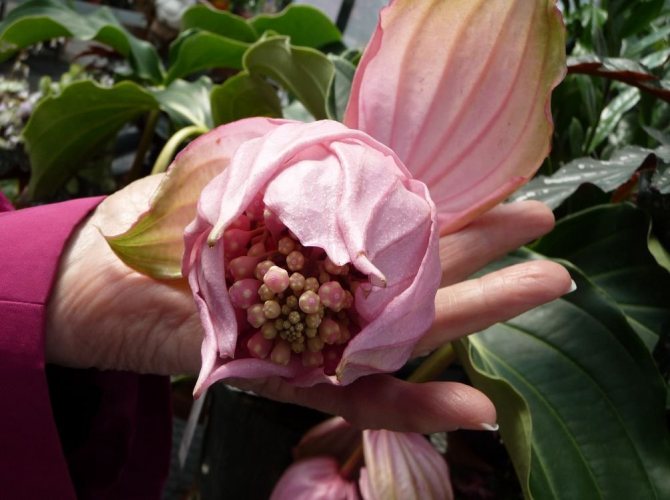

Seed reproduction is carried out in February-March.

